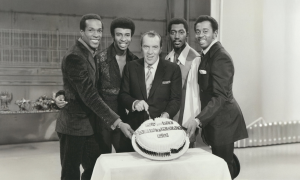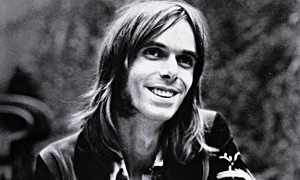Home » Jazz Articles » Film Review » Blue Wild Angel: Jimi Hendrix at the Isle of Wight
Blue Wild Angel: Jimi Hendrix at the Isle of Wight
 Principally a concert film of Jimi Hendrix's set at the 1970 Isle of Wight Festival, his last British date, Blue Wild Angel begins, not with the show itself, but with material gathered from several sources. We see Hendrix with Dick Cavett, at Berkeley, and at Woodstock, each image and bit of narration presumably a primer for viewing, and understanding, what happened at the Isle of Wight. Hendrix, apparently, didn't want to go, instead preferring to remain in New York and work on his studio creations. I am not sure if one is supposed to be more impressed with Hendrix's Isle of Wight performance with this information than without it, but if we discount the fantastically amusing aging hippie with her bit about "fun, youth, beautiful, all are welcome" at the festival's outset, the first genuine imparting of anything that might relate to Hendrix, that doesn't seem somewhat contrived, occurs as we watch him make his way from his dressing room to the stage. In a long traveling shot, director Murray Lerner moves his camera when Hendrix moves, stops it when he stops, becoming blocked behind a pole, a stack of cases, continuing on to the other side. Hendrix walks as if dazed while the Stones' "You Can't Always Get What You Want" plays over the backstage speakers. A young, attractive French reporter sidles up to him, asks a truly vapid question, and receives an answer voiced like she isn't even there. Then Hendrix, sounding more like himself, responds to the woman again, properly, closely, in a soft voice, as if she were a confidante. A crude swish-pan and we are transported directly behind the stage where a disheveled Hendrix asks a stagehand how "God Saves the Queen" goes. The hand hums the opening, and apparently this is enough.
Principally a concert film of Jimi Hendrix's set at the 1970 Isle of Wight Festival, his last British date, Blue Wild Angel begins, not with the show itself, but with material gathered from several sources. We see Hendrix with Dick Cavett, at Berkeley, and at Woodstock, each image and bit of narration presumably a primer for viewing, and understanding, what happened at the Isle of Wight. Hendrix, apparently, didn't want to go, instead preferring to remain in New York and work on his studio creations. I am not sure if one is supposed to be more impressed with Hendrix's Isle of Wight performance with this information than without it, but if we discount the fantastically amusing aging hippie with her bit about "fun, youth, beautiful, all are welcome" at the festival's outset, the first genuine imparting of anything that might relate to Hendrix, that doesn't seem somewhat contrived, occurs as we watch him make his way from his dressing room to the stage. In a long traveling shot, director Murray Lerner moves his camera when Hendrix moves, stops it when he stops, becoming blocked behind a pole, a stack of cases, continuing on to the other side. Hendrix walks as if dazed while the Stones' "You Can't Always Get What You Want" plays over the backstage speakers. A young, attractive French reporter sidles up to him, asks a truly vapid question, and receives an answer voiced like she isn't even there. Then Hendrix, sounding more like himself, responds to the woman again, properly, closely, in a soft voice, as if she were a confidante. A crude swish-pan and we are transported directly behind the stage where a disheveled Hendrix asks a stagehand how "God Saves the Queen" goes. The hand hums the opening, and apparently this is enough. From a filmic perspective, Blue Wild Angel is typical of its genre. Match cuts between several camera angles, a prevailing stasis within most shots, and a few "quirks" some might find slightly annoying—four thin, blue lines run the length of the frame of the chief camera angle on Hendrix's right for the first third of the film, and scratches in the film's surface are later visible on the screen. But Blue Wild Angel is exemplary in conveying Hendrix's command, which is evident throughout. On a festival bill with two acts, in Miles Davis and the Who, surpassing his own artistry, Hendrix remains both consummate as a professional and unpredictable as an artist, inviting our attention. As Mitch Mitchell shambles through one of his three drum solos, Hendrix mans the stage, whispering to bassist Billy Cox, walking up to the speaker cabinets to advise a soundman, then counting the band back into ensemble mode. As the set progresses, the cutting accelerates, showmanship and montage as a race to the finish line. Hendrix would be dead within three weeks and this is a feverish performance. "Voodoo Child (Slight Return)" transitions into the closing "In From the Storm," and a blue arc light, persistently bright on the stage's far side, is like talisman and harbinger both, dreadfully fitting.
Copyright 2004 Goldmine / Krause Publications . Reprinted with permission.
Tags
PREVIOUS / NEXT
Support All About Jazz
 All About Jazz has been a pillar of jazz since 1995, championing it as an art form and, more importantly, supporting the musicians who make it. Our enduring commitment has made "AAJ" one of the most culturally important websites of its kind, read by hundreds of thousands of fans, musicians and industry figures every month.
All About Jazz has been a pillar of jazz since 1995, championing it as an art form and, more importantly, supporting the musicians who make it. Our enduring commitment has made "AAJ" one of the most culturally important websites of its kind, read by hundreds of thousands of fans, musicians and industry figures every month.



















